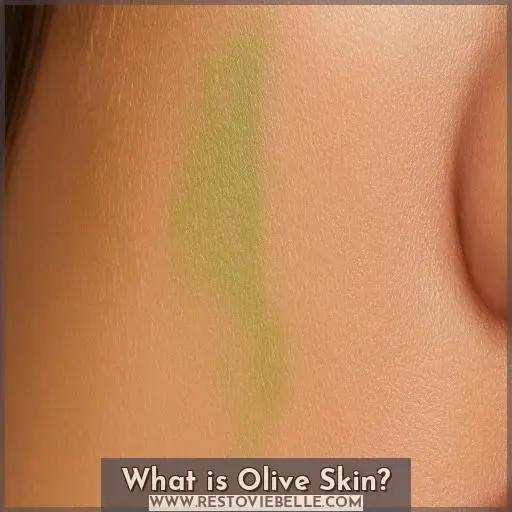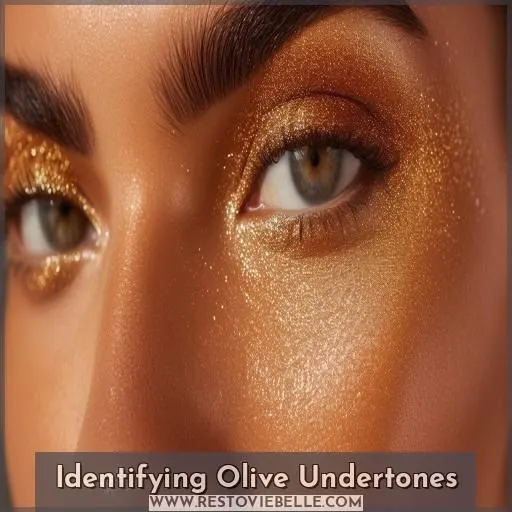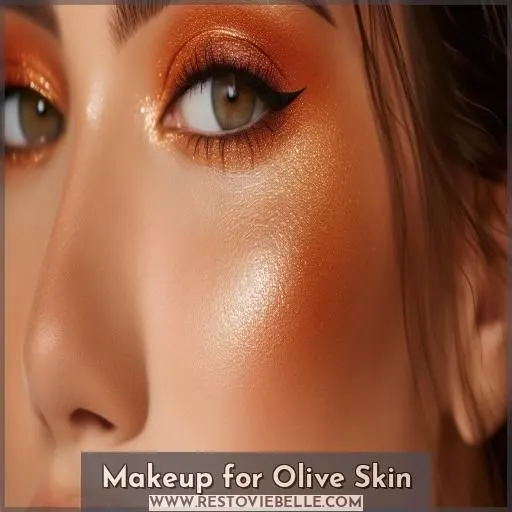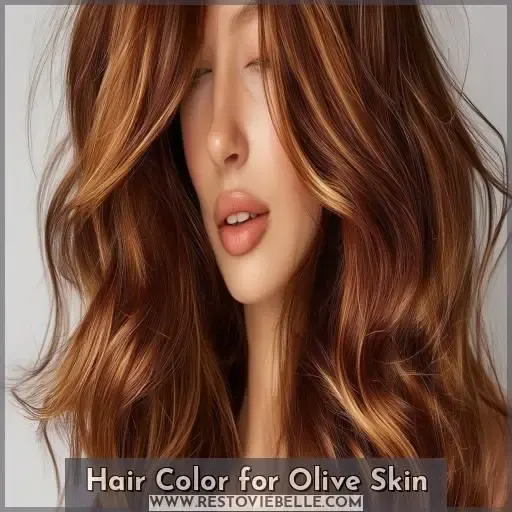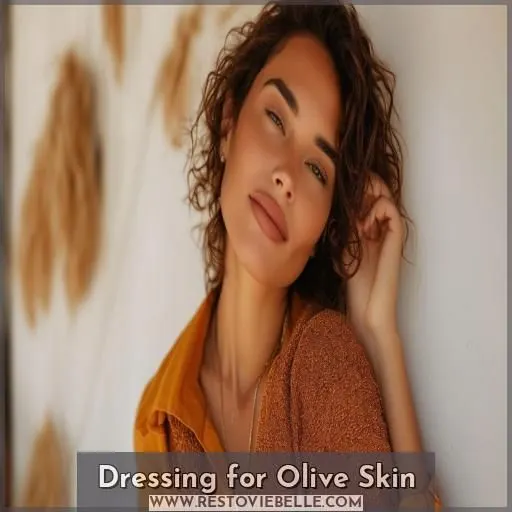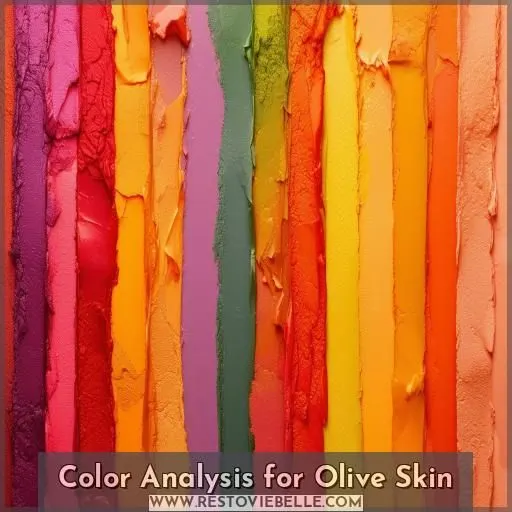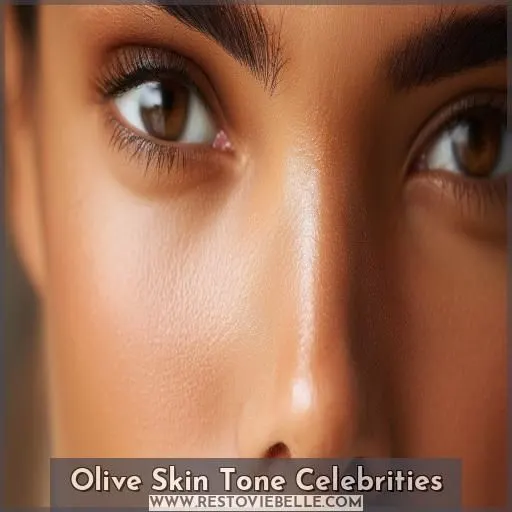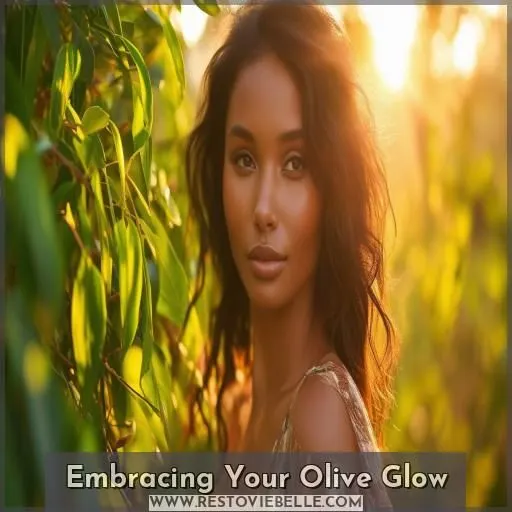This site is supported by our readers. We may earn a commission, at no cost to you, if you purchase through links.
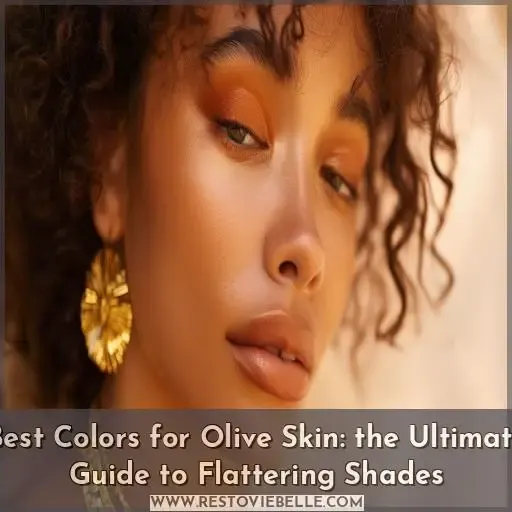 As someone with olive skin, you’ll truly shine when wearing the best colors that complement your unique undertones.
As someone with olive skin, you’ll truly shine when wearing the best colors that complement your unique undertones.
Embrace warm, earthy shades like terracotta, mustard yellow, and olive green – they’ll make your complexion glow. For a cool contrast, try jewel tones like sapphire blue or amethyst purple.
Muted neutrals with hints of green like army green or sage also flatter olive beauties.
Regarding makeup, opt for foundation with golden or greenish undertones and peach-toned blushes and lipsticks.
Table Of Contents
- Key Takeaways
- What is Olive Skin?
- Identifying Olive Undertones
- Makeup for Olive Skin
- Hair Color for Olive Skin
- Dressing for Olive Skin
- Color Analysis for Olive Skin
- Olive Skin Tone Celebrities
- Embracing Your Olive Glow
- Frequently Asked Questions (FAQs)
- What colors look best on olive skin tones?
- Is olive skin warm or cool?
- What ethnicity has olive skin?
- What hair color looks best on olive skin tone?
- What colors should be avoided for evening wear?
- Are there seasonal color variations for olive skin?
- How do olive undertones change with age?
- What role does eye color play in color selection?
- Which accessories complement olive skin tones the best?
- Conclusion
Key Takeaways
- Girl, your olive complexion is a blessing in disguise! You’re like a rare, exotic flower that blooms in all the right shades. Rock those rich jewel tones and earthy hues – they’ll make your skin glow like the Mediterranean sun.
- Understanding your unique undertones is the key to unlocking the perfect colors. Think of it like a secret code – once you crack it, you’ll have a whole new world of gorgeous shades to flaunt.
- Don’t be afraid to experiment with bold lipstick shades and eye makeup palettes. Your olive canvas is the perfect backdrop for those daring, vibrant hues that would make others look washed out. Live a little, sunshine!
- Confidence is the best accessory, honey. Embrace your olive glow with pride, and let your natural radiance shine through. When you feel beautiful, the world can’t help but notice.
What is Olive Skin?
With olive skin, you’re part of a distinctive club. Your complexion has a subtle greenish or yellowish undertone that gives you a natural, warm glow. Whether your olive tone is light, medium, or deep, it tans easily and rarely burns. It can range from neutral to warmer undertones.
Understanding your unique coloring through color analysis is key to revealing your most flattering shades.
Identifying Olive Undertones
While olive skin is often described as having neutral undertones, it’s crucial to understand that it can also have cool or warm undertones. Determining your specific undertone will help you identify the most flattering shades, ensuring your makeup and wardrobe choices perfectly complement your unique complexion.
Neutral Undertones
You may have neutral undertones if your skin has a subtle olive or greenish tint that makes it tricky to find the right foundation shade. With neutral undertones, you’re neither cool nor warm—your coloring is balanced between the two. Here are some signs of neutral undertones:
- Jewelry-wise, you can rock both silver and gold tones.
- Your veins appear greenish rather than blue or purple.
- True reds tend to look harsh—you do better with muted, earthy shades.
- Bright white makes you look washed out—off-white or cream tones suit you better.
When it comes to color matching, the key for neutral undertones is finding that perfect in-between shade that isn’t too warm or cool.
Cool and Warm Undertones
Many confuse your neutral olive undertones as warm due to the yellow hue. However, your undertones are neutral—a unique mix of cool blue and warm yellow.
To identify cool or warm undertones, drape different fabric colors near your face. Cool undertones make you glow with blues and pinks. Warm undertones complement reds and oranges.
For olive skin, seek neutral makeup shades with hints of green or gold, avoiding overly cool or warm tones that create unflattering contrast.
Understanding your undertones guides you to the perfect colors that harmonize with your olive glow.
Makeup for Olive Skin
For an olive skin tone, selecting the right foundation shade is essential. Aim for neutral undertones with hints of green, gold, or amber to avoid an overly orange or washed-out appearance.
Regarding blush and lip colors, opt for peach, salmon, or shades with golden undertones that complement your natural warmth.
While eye makeup allows you to explore bolder hues like emerald, ruby, earth tones, and gold highlights that emphasize your unique olive glow.
Foundation Shades
Finding the perfect foundation for olive skin can be tricky.
Look for neutral undertones like green, gold, or amber to avoid an orangey cast.
For light olive skin, opt for light-to-medium shades with olive or yellow undertones.
If you have deep olive skin, reach for medium-to-tan shades with golden or green hues.
The right match will create a radiant, even complexion.
Blush and Lip Colors
When selecting blush, opt for peach or salmon shades with golden undertones. These will bring a radiant flush to your complexion.
For lips, reds with a plum or raisin base flatter olive skin beautifully. Bold hues like rubies and berries make a statement, while sheer, neutral nudes offer a softer look.
Whether warm or cool tones, find colors that complement your undertones for a glowing, complementary finish.
Eye Makeup
For olive skin, eye makeup works best with shades like emerald, ruby, and earth tones. You can experiment with bold eyeshadow formulas and a variety of color palettes . Opt for eyeliner colors in dark brown or black and mascara shades that enhance your lashes without overpowering them (Source). Avoid pastel colors and warm greens which accentuate yellow or green undertones .
Hair Color for Olive Skin
When choosing a hair color for olive skin, it’s important to focus on shades that complement your natural undertones. Natural colors like dark brown and deep black, as well as cool fashion colors like magenta pink, are particularly flattering and will enhance your radiant complexion (Source).
Natural Hair Colors
Choosing natural hair colors for olive skin can make a dramatic impact on your overall look.
Opt for shades that complement your unique undertones. Dark brown, deep mahogany, or rich espresso hues consistently flatter olive skin, preserving your natural glow . Avoid golden tones, focusing instead on cool undertones to enhance your complexion.
Hair care is essential, so use products that maintain the richness of these colors. Visiting professional hair salons guarantees that your hair color blends seamlessly with your skin tone, creating a cohesive and stunning appearance .
Embrace your natural beauty with the right hair choices.
Fashion Hair Colors
Embrace the latest fashion trends with hair colors that flatter your olive skin. Opt for shades that align with seasonal palettes for a dynamic look.
For a striking appearance, consider cool-toned reds like magenta pink, which adds vibrancy without clashing.
Seasonal trends often bring fresh palettes; stay updated to keep your style contemporary.
Celebrity inspiration: think Penélope Cruz and her rich brunettes.
Hair care tips: maintain your color’s intensity with sulfate-free products.
Leveraging color theory, avoid warm tones like golden highlights that may not complement your undertones.
Stay connected to evolving trends and your unique style.
Dressing for Olive Skin
When dressing for olive skin, it’s important to balance color contrast with your skin tone variations to highlight your natural glow. Opt for vibrant hues like magenta, deep purples, and turquoise to achieve a flattering look, while steering clear of colors that might accentuate any greenish or yellowish undertones .
Color Contrast
Regarding enhancing your olive skin with clothing, color contrast is pivotal. Grasping color theory and considering personal preferences can effortlessly elevate your style. Choose:
- High Contrast: Dark hair and light olive skin? Employ bold contrasts like deep blues and vibrant reds.
- Medium Contrast: Tanned olive tones shine with muted tones like taupe and soft rose.
- Low Contrast: For subtlety, pair similar shades—think creamy whites and mossy greens.
- Fashion Trends: Stay updated with current trends but adapt them to your skin’s seasonal changes and cultural influences for a personalized touch.
Fashion reflects your inner glow.
Skin Tone Variations
Understanding how your olive skin tone varies is key to dressing well.
People with olive skin can have light, medium, or deep variations that affect which colors look best.
For lighter olive tones, you may find bright, cool colors like turquoise, magenta, and pink make your complexion glow .
Medium olive skin benefits from rich, warm hues such as golden yellows, warm greens, and deep reds, which complement your natural warmth .
Deep olive tones thrive with intense, striking colors like deep purples, chocolate browns, and sapphire blues .
Embrace these shades to highlight your unique undertone.
Color Analysis for Olive Skin
In determining the ideal colors for your olive skin, professional color analysis can provide invaluable insights, assisting in the selection of shades that accentuate your inherent radiance . Alternatively, you can conduct a home-based color analysis using basic tools such as colored fabrics, mirrors, and natural lighting to identify your ideal palette .
Professional Color Analysis
Engaging in professional color analysis can revolutionize your approach to style, especially if you have an olive skin tone. Experts use various methods to guarantee you find your most flattering shades.
- Seasonal Color Analysis: Identifies your dominant season (e.g., Winter, Spring), helping you discover your ideal color palette .
- Color Psychology: Understands how different colors impact your appearance and mood, ensuring your choices boost confidence.
- Color Swatches: Professionals provide physical or digital swatches to guide your wardrobe and makeup selections .
- Virtual Color Consultation: Offers personalized advice through online platforms, making color analysis accessible from anywhere.
DIY Color Analysis
Shifting from professional analysis, let’s explore DIY color analysis tailored for olive skin.
You can effectively utilize online color tools and DIY color swatches to identify your ideal palette. Start by comparing your skin tone with various seasonal color guides to see which resonates best.
Tools like the Colorwise app offer personalized color recommendations based on your skin’s undertone and overtone.
Creating a personal color palette involves trial and error; explore colors that enhance your natural undertone.
Olive Skin Tone Celebrities
Some of the most admired celebrities have olive skin tones, from fair to deep shades. By looking at these stars and their color choices, you can find inspiration to highlight your unique complexion effectively .
Fair Olive Celebrities
When you think about fair olive celebrities, Angelina Jolie and Lea Michele come to mind. They’re known for their subtle yet distinct greenish undertones.
To enhance your fair olive complexion, focus on colors that match or complement your natural skin undertones. Cool jewel tones like emerald and sapphire, as well as rich shades like burgundy and deep purple, make their skin pop. Avoid mustards or oranges that might highlight unwanted yellowish hues.
Deep Olive Celebrities
When spotting celebrities with deep olive skin, examine how they employ color to elevate their natural radiance.
Consider Eva Mendes or Zoe Saldana; their wardrobe selections center around rich, vibrant hues. They lean towards jewel tones like emerald green, royal blue, and ruby red, which complement their skin’s depth.
Regarding makeup, you’ll notice they often select foundations with neutral or slightly cool undertones to prevent looking washed out. Utilizing warm bronzers and blushes in terracotta or peach creates a healthy, sun-kissed effect.
Draw inspiration from their wardrobe and beauty choices to reflect your stunning deep olive skin.
Embracing Your Olive Glow
Embrace your olive glow by boosting your confidence with the right colors and style tips that enhance your natural radiance. Remember, the right shades can make a significant difference in how you feel and present yourself (Source).
Confidence Boosters
Embrace your olive skin! It’s a rarity to be celebrated. Your unique undertones hold a natural radiance that’s truly alluring.
Rock those bold lip colors and eye-catching eye makeup shades—you were born to pull them off effortlessly. Strut confidently, knowing your olive glow commands attention.
Share your beauty secrets with pride; you’re an inspiration for others to find confidence in their skin. Olive skin is in; it’s the epitome of modern, exotic beauty.
Flaunt your one-of-a-kind complexion with olive skin confidence, pride, and unabashed olive skin beauty.
Style Tips
With your new confidence in rocking olive skin tones, it’s time to embrace your natural glow with these style tips:
- Experiment with lightweight bronzers for a sun-kissed look.
- Accessorize with rose gold or copper jewelry for a warm, radiant vibe.
- Rock oversized sunnies with warm, tortoiseshell frames.
When building your olive skin wardrobe, don’t be afraid to mix and match colors – you’ve got a versatile canvas! Pro tip: invest in pieces that flatter your complexion, making you feel like the trendsetter you are.
Frequently Asked Questions (FAQs)
What colors look best on olive skin tones?
You may think olive skin limits your color options, but it actually opens up a vibrant palette. Embrace rich jewel tones like emerald, amethyst, and ruby for a radiant glow that celebrates your unique complexion.
Is olive skin warm or cool?
You’re neither warm nor cool – olive skin has neutral undertones. While yellowish tones can appear warm, the greenish hue actually stems from a mix of cool blue and warm yellow pigments in your complexion.
What ethnicity has olive skin?
Wondering which ethnicities boast that envy-inducing olive skin tone? From Southern Europeans to Middle Easterners, and beyond – countless cultures are blessed with this versatile, sun-kissed radiance. Embrace your natural beauty by exploring flattering hues that complement your unique complexion.
What hair color looks best on olive skin tone?
For olive skin tones, you’ll look best with your natural hair color. For graying hair, opt for cool shades and avoid overly warm highlights. Cooler reds or magentas provide a nice contrast without clashing.
What colors should be avoided for evening wear?
For evening wear, it’s best to avoid dull, lifeless colors like beige, tan, and washed-out pastels that can make your olive complexion look sallow. Embrace rich, vibrant hues that complement your warm undertones instead.
Are there seasonal color variations for olive skin?
Yes, olive skin tones can benefit from wearing seasonal color palettes. For spring and summer, opt for vibrant hues like coral, fuchsia, or turquoise. In fall and winter, richer shades like plum, forest green, or burgundy will flatter your complexion beautifully.
How do olive undertones change with age?
As you age, your olive undertones may become more pronounced. Don’t worry – simply adjust your makeup and clothing colors to flatter your evolving skin tone. Richer, deeper shades often complement maturing olive complexions beautifully.
What role does eye color play in color selection?
Let’s say your eye color reflects the depth of the ocean – the key to flattering hues lies in mirroring those tones. With olive skin, cooler eye shades like emerald or sapphire work beautifully, allowing your natural radiance to shine through.
Which accessories complement olive skin tones the best?
For olive skin tones, accessorize with jewelry like gold, bronze, or earth-toned gems. These metallic hues complement neutral undertones beautifully. Vibrant accessories like scarves in rich, cool tones like plum or teal also flatter your natural radiance.
Conclusion
Like a radiant olive branch, your complexion shines when adorned with the best colors for olive skin.
Embrace earthy terracottas, rich jewel tones, and muted greens to flatter your unique undertones.
Opt for golden or greenish foundations, peach blushes, and complementary lip colors.
Confidently rock shades that make your olive glow radiate, and bask in the beauty of your Mediterranean-inspired hues.
